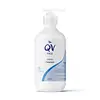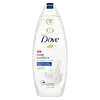What's inside
What's inside
 Key Ingredients
Key Ingredients

 Benefits
Benefits

 Concerns
Concerns

 Ingredients Side-by-side
Ingredients Side-by-side

Water
Skin ConditioningCarthamus Tinctorius Seed Oil
MaskingPetrolatum
EmollientGlycerin
HumectantSodium Laureth Sulfate
CleansingLauryl Betaine
CleansingXanthan Gum
EmulsifyingGuar Hydroxypropyltrimonium Chloride
Skin ConditioningTocopherol
AntioxidantMethylparaben
PreservativePropylparaben
PreservativeSodium Polyacrylate
AbsorbentCitric Acid
BufferingSodium Lauroyl Lactylate
EmulsifyingCeramide EOP
Skin ConditioningCeramide AP
Skin ConditioningCeramide NP
Skin ConditioningPhytosphingosine
Skin ConditioningCholesterol
EmollientEthylhexylglycerin
Skin ConditioningCarbomer
Emulsion StabilisingWater, Carthamus Tinctorius Seed Oil, Petrolatum, Glycerin, Sodium Laureth Sulfate, Lauryl Betaine, Xanthan Gum, Guar Hydroxypropyltrimonium Chloride, Tocopherol, Methylparaben, Propylparaben, Sodium Polyacrylate, Citric Acid, Sodium Lauroyl Lactylate, Ceramide EOP, Ceramide AP, Ceramide NP, Phytosphingosine, Cholesterol, Ethylhexylglycerin, Carbomer
Water
Skin ConditioningCocamidopropyl Betaine
CleansingSodium Hydroxypropyl Starch Phosphate
AbrasiveLauric Acid
CleansingSodium Lauroyl Glycinate
CleansingSodium Lauroyl Isethionate
CleansingHydrogenated Soybean Oil
EmollientGlycine Soja Oil
EmollientSodium Chloride
MaskingGlycerin
HumectantParfum
MaskingStearic Acid
CleansingPalmitic Acid
EmollientPhenoxyethanol
PreservativeGuar Hydroxypropyltrimonium Chloride
Skin ConditioningCitric Acid
BufferingBHT
AntioxidantTetrasodium EDTA
Iodopropynyl Butylcarbamate
PreservativeLinalool
PerfumingLimonene
PerfumingHexyl Cinnamal
PerfumingCoumarin
PerfumingCitronellol
PerfumingBenzyl Alcohol
PerfumingAlpha-Isomethyl Ionone
PerfumingWater, Cocamidopropyl Betaine, Sodium Hydroxypropyl Starch Phosphate, Lauric Acid, Sodium Lauroyl Glycinate, Sodium Lauroyl Isethionate, Hydrogenated Soybean Oil, Glycine Soja Oil, Sodium Chloride, Glycerin, Parfum, Stearic Acid, Palmitic Acid, Phenoxyethanol, Guar Hydroxypropyltrimonium Chloride, Citric Acid, BHT, Tetrasodium EDTA, Iodopropynyl Butylcarbamate, Linalool, Limonene, Hexyl Cinnamal, Coumarin, Citronellol, Benzyl Alcohol, Alpha-Isomethyl Ionone
 Reviews
Reviews

Ingredients Explained
These ingredients are found in both products.
Ingredients higher up in an ingredient list are typically present in a larger amount.
Citric Acid is an alpha hydroxy acid (AHA) naturally found in citrus fruits like oranges, lemons, and limes.
Like other AHAs, citric acid can exfoliate skin by breaking down the bonds that hold dead skin cells together. This helps reveal smoother and brighter skin underneath.
However, this exfoliating effect only happens at high concentrations (20%) which can be hard to find in cosmetic products.
Due to this, citric acid is usually included in small amounts as a pH adjuster. This helps keep products slightly more acidic and compatible with skin's natural pH.
In skincare formulas, citric acid can:
While it can provide some skin benefits, research shows lactic acid and glycolic acid are generally more effective and less irritating exfoliants.
Most citric acid used in skincare today is made by fermenting sugars (usually from molasses). This synthetic version is identical to the natural citrus form but easier to stabilize and use in formulations.
Read more about some other popular AHA's here:
Learn more about Citric AcidGlycerin is already naturally found in your skin. It helps moisturize and protect your skin.
A study from 2016 found glycerin to be more effective as a humectant than AHAs and hyaluronic acid.
As a humectant, it helps the skin stay hydrated by pulling moisture to your skin. The low molecular weight of glycerin allows it to pull moisture into the deeper layers of your skin.
Hydrated skin improves your skin barrier; Your skin barrier helps protect against irritants and bacteria.
Glycerin has also been found to have antimicrobial and antiviral properties. Due to these properties, glycerin is often used in wound and burn treatments.
In cosmetics, glycerin is usually derived from plants such as soybean or palm. However, it can also be sourced from animals, such as tallow or animal fat.
This ingredient is organic, colorless, odorless, and non-toxic.
Glycerin is the name for this ingredient in American English. British English uses Glycerol/Glycerine.
Learn more about GlycerinThis ingredient is derived from guar gum.
It is a conditioning ingredient, meaning it helps soften skin and hair.
Water. It's the most common cosmetic ingredient of all. You'll usually see it at the top of ingredient lists, meaning that it makes up the largest part of the product.
So why is it so popular? Water most often acts as a solvent - this means that it helps dissolve other ingredients into the formulation.
You'll also recognize water as that liquid we all need to stay alive. If you see this, drink a glass of water. Stay hydrated!
Learn more about Water